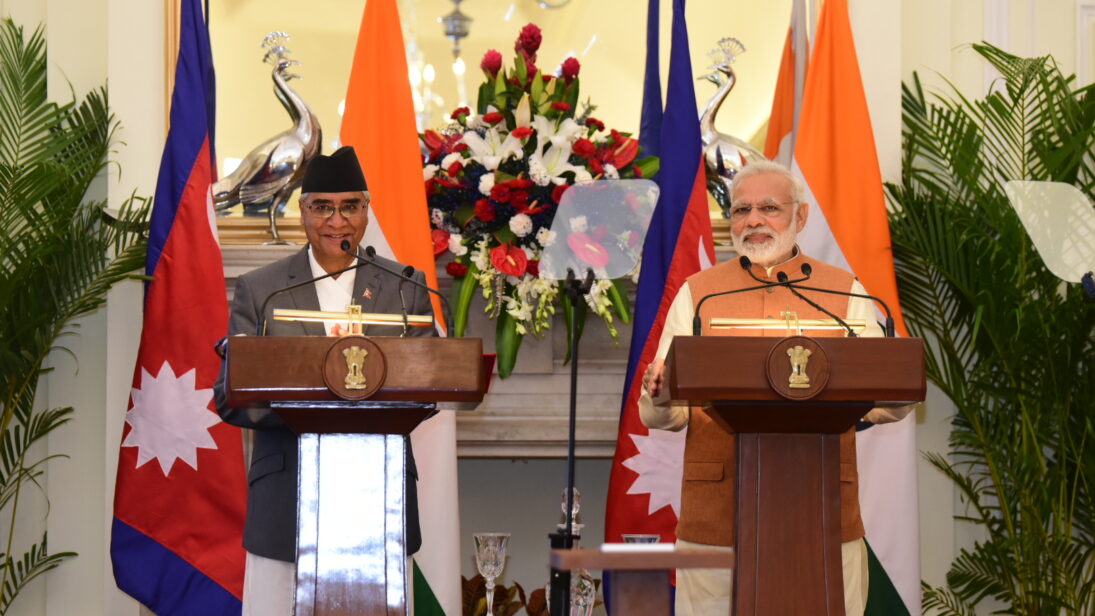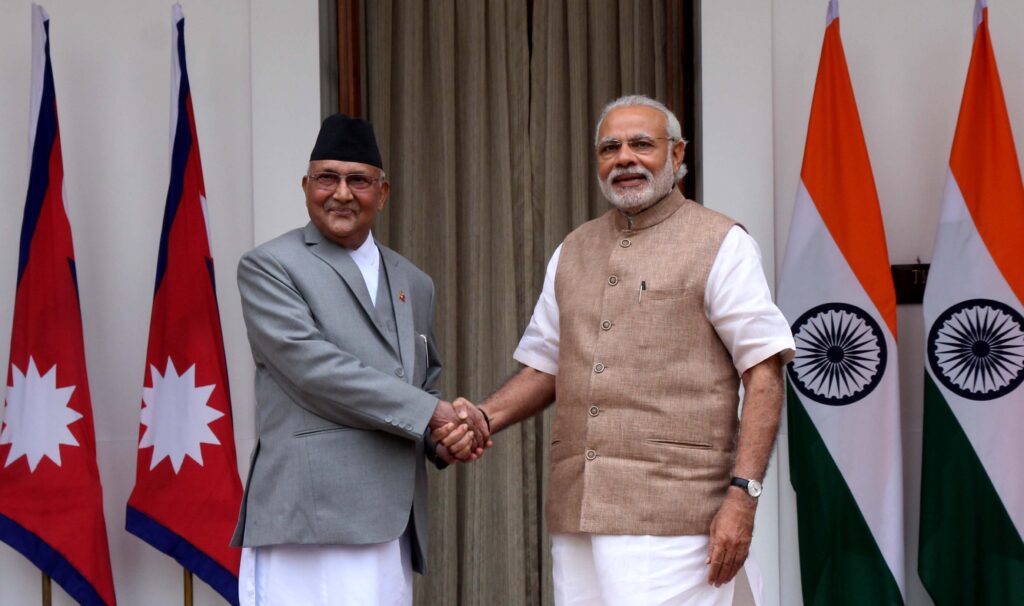
On January 10, 2022, Nepali Prime Minister Sher Bahadur Deuba was supposed to travel to Gujarat, India to participate in the Vibrant Gujarat Investor Summit at India’s invitation. However, both countries cancelled the visit at the last hour as COVID-19 cases caused by the Omicron variant started to surge. Even as this has halted the in-person meeting between the Prime Ministers, the plans for the engagements exhibit easing tensions between India and Nepal. While the two countries have experienced frictions over the last seven years concerning India’s alleged involvement in a border blockade in 2015 and boundary disputes in the Kalapani region, India and Nepal are making efforts to reboot their relationship. Prime Minister Deuba has reached out to India on several occasions since taking office six months ago, and India’s positive responses in return keep hopes high.
The “Hostile” Years
India-Nepal ties reached a low point in November 2019, when Nepal’s then Prime Minister KP Sharma Oli’s government objected to a newly released political map of India. Nepal’s Ministry of Foreign Affairs had alleged that the new Indian map had wrongly shown Nepalese territory in the Kalapani region as Indian territories. However, India refuted the allegations, however, in May 2020, the border issue made headlines again after India’s Defense Minister inaugurated a road in the Kalapani region. The bilateral ties went further downhill after the Nepalese Parliament passed a new map showing disputed territories with India as its own in June 2020. India protested with a strongly-worded statement saying: “such artificial enlargement of territorial claims will not be accepted by India.”
While the two countries have experienced frictions over the last seven years concerning India’s alleged involvement in a border blockade in 2015 and boundary disputes in the Kalapani region, India and Nepal are making efforts to reboot their relationship.
Prime Minister Oli exacerbated India and Nepal’s existing diplomatic row with his inflammatory culturally-sensitive comments, which further soured relations between the two countries. In June 2020, during the 207th anniversary celebration of Adikavi Bhanu Bhakta Acharya’s birth—the author of the Ramayana in the Nepali language—Oli stated that the real Ayodhya was in Nepal and not in India. The incident had caused uproar in India and, amidst criticism, Nepal’s Foreign Ministry stated that the “remarks made by the Prime Minister are not linked to any political subject and have no intention at all to hurt the feeling and sentiment of anyone.” By this time, the controversy over border tensions had permeated Nepali social media with #GoBackIndia and #BackOffIndia trending on Facebook and Twitter. As people-to-people relations comprise a fundamental component of Nepal-India bilateral ties, the public outcry only deepened the tensions.
In July 2021, KP Oli resigned after Nepal’s Supreme Court reinstated the Parliament that Oli had dissolved twice while battling to hold onto power. Soon after the court verdict, the Nepali Congress Party (NCP) President Sher Bahadur Deuba was appointed Prime Minister. He won a vote of confidence in the Parliament with the support of a coalition, which included parties like the Maoist Center and the Janata Samajbadi Party. Deuba’s appointment came as a relief to India after Oli’s diplomatic controversies during his Premiership and Prime Minister Modi took to Twitter to congratulate Prime Minister Deuba.
A New Phase
The NCP has historically maintained cordial ties with India due to its foundations in its neighboring country: many of the party’s top leadership studied in India, including its founder Subarna Shumsher Rana. The party itself was founded in the Indian city of Kolkata in 1948. There has always been an ideological and cultural bond between India and the NCP. Soon after Deuba was appointed Prime Minister, Vijay Chauthaiwale, head of the Foreign Affairs Department of India’s ruling Bhartiya Janta Party (BJP), visited Nepal in August 2021. The visit was seen as India’s willingness to resume discussions and improve ties with Nepal. In reciprocation, a three-member delegation of the NCP arrived in Delhi in October 2021. Those traveling to Delhi included former Minister of Foreign Affairs Prakash Sharan Mahat, former Minister of State for Finance Udaya Shumsher Rana, and former Assistant Minister in Ministry of Federal Affairs and Local Development of Nepal Ajay Chaurasiya, who held meetings with India’s External Affairs Minister S. Jaishankar and BJP President JP Nadda. In November 2021, Nepal’s Army Chief General Prabhu Ram Sharma also paid a four-day visit to India and was conferred with the honorary rank of General of the Indian Army by President Ram Nath Kovind. This tradition has continued on a reciprocal basis in the last seven decades between the two armies. Nepali Army Chief Sharma’s visit to India assumed a symbolic significance of defense ties between India and Nepal.

The Future
The recent bonhomie between India and Nepal has hopeful potential. However, Deuba may have a short spell as the Prime Minister, as Nepal heads into general elections at the end of 2022. Hence, any extreme turns around in ongoing negotiations are unlikely to be taken by Prime Minister Deuba. Additionally, looming political instability, especially internal feuds between the ruling alliance and corruption, make the prospects of an immediate resolution of border tensions with India unlikely. On the other hand, India has earned a name for itself through its timely delivery of the transborder petroleum pipeline, a 34 km long railway route connecting bordering towns of Jayanagar in India and Kurtha in Nepal, and financial assistance to Nepal in building schools, hospitals, and 50,000 houses damaged in 2015 earthquake. Still, India faces the problem of taking an “ad hoc” approach to its Nepal policy reflected from its reactive rather than proactive approach. With Prime Minister Deuba at the helm, India has a better opportunity to deepen its ties and win back goodwill. However, technical challenges will continue to overpower bilateral relations. For instance, India maintains that the Kalapani region belongs to India while Nepal also claims the region for itself. Since the region forms a tri-junction between India, Nepal, and China, and is strategically important to India, a one-sided solution is unlikely in the scenario of a border dispute. Nepal will need to consider India’s national security concerns looming from China’s expansionist attempts along the Line of Actual Control.
While the border dispute seems unlikely to be resolved any time soon, the two neighbors can continue to build on the strong history of people-to-people ties and need to cooperate on trade, cultural exchange, and areas of regional concern, including the ongoing pandemic.
Even with warming ties, the border continues to cause rifts in the relationship and has the power to spur public protests in Nepal. For instance, in December 2021, Prime Minister Modi announced the expansion of a road in the Kalapani region. Nepal protested by urging India to “stop the construction/expansion of any kind of unilateral road passing through Nepali territory.” Actions like this will continue to obstruct bilateral cooperation. The NCP was also among the parties which had supported Oli in revising the map of Nepal in 2020; hence, no party in Nepal, including NCP, seems to be taking the risk of not addressing the border dispute with India, especially as it has become a matter of nationalism in Nepal. While the border dispute seems unlikely to be resolved any time soon, the two neighbors can continue to build on the strong history of people-to-people ties and need to cooperate on trade, cultural exchange, and areas of regional concern, including the ongoing pandemic.
Note: The views and opinions expressed in this article are those of the authors and do not necessarily reflect any organization or affiliations’ official policy or position.
***


